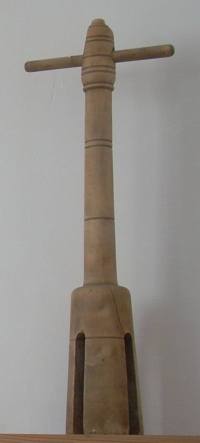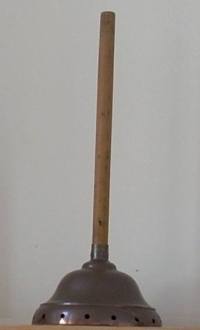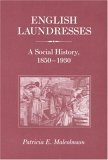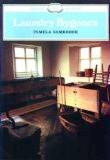-
History of:
- Resources about:
- More:
- Baby walkers
- Bakehouses
- Bed warmers
- Beer, ale mullers
- Besoms, broom-making
- Box, cabinet, and press beds
- Butter crocks, coolers
- Candle snuffers, tallow
- Clothes horses, airers
- Cooking on a peat fire
- Drying grounds
- Enamel cookware
- Fireplaces
- Irons for frills & ruffles
- Knitting sheaths, belts
- Laundry starch
- Log cabin beds
- Lye and chamber-lye
- Mangles
- Marseilles quilts
- Medieval beds
- Rag rugs
- Rushlights, dips & nips
- Straw mattresses
- Sugar cutters - nips & tongs
- Tablecloths
- Tinderboxes
- Washing bats and beetles
- Washing dollies
- List of all articles
Subscribe to RSS feed or get email updates.
Whatever its form or name, and both were subject to regional variation, the dolly was generally operated as a Cumberland author ... described it: "The dolly is plunged into the mass and worked by the dollier with both arms, with a curious lateral motion to left and right alternately..."
Patricia E. Malcolmson, English Laundresses: A Social History, 1850-1930, 1986
Patricia E. Malcolmson, English Laundresses: A Social History, 1850-1930 from Amazon.com
or Amazon UK
Ponch, punch or ?
Ponches, possers, plungers, stompers, dollies - naming old laundry tools
>>>> More on washing dollies etc.
 OldandInteresting has mentioned
before that it's difficult to get a detailed picture of regional differences in
the names for simple domestic items - let alone differences from one English-speaking
country to another. The butter pats/Scotch hands
names are just one example.
OldandInteresting has mentioned
before that it's difficult to get a detailed picture of regional differences in
the names for simple domestic items - let alone differences from one English-speaking
country to another. The butter pats/Scotch hands
names are just one example.
Untangling the variety of words is complicated when it comes to historic laundry items. Washing and other laundry tasks were often done by people near the bottom of the social ladder. Their work and vocabulary didn't attract much interest from writers - far less from dictionary-makers. Sometimes we get pre-1800 clues from descriptions of textile manufacture. After 1800 there were plenty of household advice manuals but these books weren't generally about the way laundry was really done by self-employed washerwomen and working class housewives, and often focussed on how to run more prosperous households.
The names dolly, posser, ponch, punch, stomp, beater, plunger, pounder, and dasher have become blurred over time and are sometimes used interchangeably....
There is a basic difference between the dolly and the dasher. The dolly is used to pound the clothes and ..may [also] be used to grab onto and move the clothes through the water. The dasher, in addition to pounding, forces water through the clothes, especially on the downward stroke.
Lee M Maxwell, Save Womens Lives: History of Washing Machines, 2003
 We can understand why you
would call the laundry tool in the first photo a laundry ponch or punch. It was
used for punching down on washing in a tub, squeezing and forcing out dirt. In some
places ponch was certainly its name. Yet there were areas of the UK where this kind
of tool was called a posser, or even a washing dolly,
dasher, stomper etc. Many were used
by women standing over a tub placed on the floor. Some had short handles for
use in a sink . In the UK posser often suggests a metal cone on a handle
manufactured in the 19th or 20th century, like the one pictured left. In the US
this is generally called a plunger, except for a new generation of
low-tech laundry aids very like the old possers but with names like "hand
washer".
We can understand why you
would call the laundry tool in the first photo a laundry ponch or punch. It was
used for punching down on washing in a tub, squeezing and forcing out dirt. In some
places ponch was certainly its name. Yet there were areas of the UK where this kind
of tool was called a posser, or even a washing dolly,
dasher, stomper etc. Many were used
by women standing over a tub placed on the floor. Some had short handles for
use in a sink . In the UK posser often suggests a metal cone on a handle
manufactured in the 19th or 20th century, like the one pictured left. In the US
this is generally called a plunger, except for a new generation of
low-tech laundry aids very like the old possers but with names like "hand
washer".
Using a dolly peg is a strenuous task, requiring both a rotational and a vertical movement. The washing punch was used to similar effect but with less of a rotational action. Possers were used with a vigorous vertical movement...
Pamela Sambrook, Laundry Bygones, 1983
This page quotes some modern writers who've touched on the topic of names for this
kind of tool. Meanwhile, the older washing bat,
beetle or battledore used for laundry has its own naming issues.
This interesting blog with a picture of a wonderful 17th century carved
laundry bat tells how the curator of colonial American reproductions at Plimoth
in Massachusetts settled on 'battledore' as the name for their squarish washing
bats. She was up against the usual problem of finding no consistent, tidy distinction
between battledores and beetles, batting-staffs and bats, that held good from region
to region. Though she found that battledore was certainly used to describe a flat,
square shape, we must assume it could also refer to a long, thin cylindrical shape,
since there is a 1655 recipe calling for a battledore to be used like a rolling
pin. (In
The Queens
Closet Opened (1658)
by Hannah Wolley.)
[In the early 1900s]... a 'dolly'... was a four- or five-legged stool attached to an upright handle across which there was a crossbar handle. In Birmingham the stool was replaced by a block of wood, indented at intervals, which was properly called a laundry punch; in the North-East it was replaced by a perforated copper cone known locally as a 'possing stick'.
Carl Chinn, They Worked All Their Lives: Women of the Urban Poor, 1880-1939, 1988
Pamela Sambrook, Laundry Bygones,
from Amazon.com or Amazon UK
Other hand laundry tools:
Washing beetles and bats
Washing dollies
Washboards
More on on old laundry methods:
History of laundry
Laundry from 1800
History of ironing
 23 July 2009
23 July 2009
You may like our new sister site Home Things Past where you'll find articles about antiques, vintage kitchen stuff, crafts, and other things to do with home life in the past. There's space for comments and discussion too. Please do take a look and add your thoughts. (Comments don't appear instantly.)
For sources please refer to the books page, and/or the excerpts quoted on the pages of this website, and note that many links lead to museum sites. Feel free to ask if you're looking for a specific reference - feedback is always welcome anyway. Unfortunately, it's not possible to help you with queries about prices or valuation.




